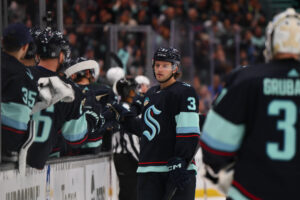The Philadelphia Flyers penalty kill has been a focal part of this team for the last few years. It has been one of their many problems and has yet to see any kind of fix or change. The time has long come for the Flyers to take a look and do something about it.
Time To Make A Change On Flyers Penalty Kill
By The Numbers
The Flyers sit second to last in the league with a penalty kill percentage of just 69.1%. Only the Florida Panthers have a worse percentage at 68.4%. The Flyers may not be the worst but they’re not far off the mark.
Philadelphia has given up the most power-play goals (17) during their 55 total times shorthanded, fifth-most in the league. Their 69 minor penalties are the most in the league.
A team that has had this many issues on the penalty kill needs to avoid taking as many penalties as they have so far this season. Being called for a penalty at least once a game is typically inevitable. However, being able to defend when put into that opportunity is a must.
Shots Allowed

As shown in the chart above created by Michah Blake McCurdy of hockeyviz.com, the Flyers penalty kill is giving up too many shots directly in front of the net. Allowing opposing teams to shoot from 20ft away is closer is not ideal to killing penalties.
This goes into the Flyers strategy on the penalty kill and just how other teams are able to get that many shots from in tight.
Penalty Kill Strategy
The Flyers have been plagued by leaving players uncovered in front of their own net. It was evident on Joe Pavelski‘s power-play during the San Jose Sharks 4-3 overtime victory.
While Kevin Labanc made a smart play by faking the shot, there is no one covering Pavelski by the right side of the net. With Calvin Pickard biting on the shot, Pavelski has nothing but an empty net staring back at him. Both Radko Gudas and Dale Weise are focused on the initial fake shot and covering the area around Tomas Hertl in front of the net.
This allows Pavelski to hang around the side of the net, waiting for the pass from Labanc. One of Weise or Gudas would have been better focusing on the space between Pavelski and the also open Logan Couture.
This has not been a one time trend for the Flyers either. Going back to the team’s 3-0 loss to the Boston Bruins, the team allowed Jake DeBrusk to position himself at the front of the net.
Robert Hagg, Andrew MacDonald, and Claude Giroux are around DeBrusk, however, none of them skate over to cover him in front of Brian Elliott. He is in perfect position to tip home the pass from David Krejci.
Lack Of Pressure
The Flyers penalty kill and their lack of pressure have also been one of there downfalls. That is evident during both Pavelski and DeBrusk’s goal.
On Pavelski’s goal, Labanc wins the puck battle behind the net and finds Burns at the point. After Burns passes it back to him, Labanc is able to skate in with open ice in front of him. Sean Couturier has to come from across the ice to try and cover him while Ivan Provorov hopes for a blocked shot.
For DeBrusk, he skates down from the boards passing to and switching spots with Krejci before the goal happens. No pressure is given to DeBrusk when he makes the initial pass to Krejci or when he skates in on the net.
There will always be someone uncovered during a penalty kill. However, allowing teams to freely skate around in the zone and put little to no pressure on them will make the disadvantage even worse. It gives them the opportunity to set up and seemingly find a man in front of the goaltender.
System Change Or Coaching Change
The Flyers penalty kill and their downward trend is not something new to the team this season. In fact, the team has been towards the bottom of the league in the previous four seasons as well. The Flyers have been 20th or worse since 2014-15. Their best in that span was their 80.5% finish in 2015-16, though they would finish with the 20th worst penalty kill that season.
The team finished last season with the third to last penalty-kill percentage at 75.8%. This was only 2.6% off the New York Islanders, who finished with the worst percentage.
The last time the Flyers finished with a top-10 penalty kill was back in 2013-14 when they finished with the seventh-best percentage at 84.8%. This came despite being shorthanded 316 times over the season, the second most times. This was Ian Laperriere‘s first season with the team. He was named an assistant coach when Craig Berube was promoted to head coach at the start of that season.
For the Flyers penalty kill to show improvement, the team will have to look at everything involved and make some kind of change. Whether that is changing their system or looking internally at the coaching staff, something needs to be changed. It is clear that there is a problem and has been one for years.
The team needs to buck the trend if they want a chance at truly competing.
Main Photo by Kate Frese (@KateFresePhoto), licensed to Last Word on Hockey. The Photographer retains all rights to the photograph.






